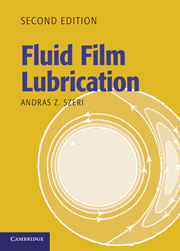Book contents
- Frontmatter
- Contents
- Preface to the Second Edition
- Preface to the First Edition
- Chapter 1 Introduction
- CHAPTER 2 Basic Equations
- CHAPTER 3 Thick-Film Lubrication
- CHAPTER 4 Dynamic Properties of Lubricant Films
- CHAPTER 5 Effects of Fluid Inertia
- CHAPTER 6 Flow Stability and Transition
- CHAPTER 7 Turbulence
- CHAPTER 8 Elastohydrodynamic Lubrication
- CHAPTER 9 Thermal Effects
- CHAPTER 10 Lubrication with Non-Newtonian Fluids
- CHAPTER 11 Gas Lubrication
- CHAPTER 12 Molecularly Thin Films
- CHAPTER 13 Biotribology
- Index
Preface to the Second Edition
Published online by Cambridge University Press: 05 June 2012
- Frontmatter
- Contents
- Preface to the Second Edition
- Preface to the First Edition
- Chapter 1 Introduction
- CHAPTER 2 Basic Equations
- CHAPTER 3 Thick-Film Lubrication
- CHAPTER 4 Dynamic Properties of Lubricant Films
- CHAPTER 5 Effects of Fluid Inertia
- CHAPTER 6 Flow Stability and Transition
- CHAPTER 7 Turbulence
- CHAPTER 8 Elastohydrodynamic Lubrication
- CHAPTER 9 Thermal Effects
- CHAPTER 10 Lubrication with Non-Newtonian Fluids
- CHAPTER 11 Gas Lubrication
- CHAPTER 12 Molecularly Thin Films
- CHAPTER 13 Biotribology
- Index
Summary
For the successful operation of mechanical devices, from spinning computer disks to automobiles to large electric generators of nuclear power stations, it is essential that the components that are destined to move relative to one another do so with low friction and rate of wear. This is made possible through appropriate design and utilization of fluid film bearings. Traditionally, fluid film lubrication was a purely mechanical subject, but with the emergence of bioengineering, the technology also finds application in lubricating artificial joints, contact lenses, and mechanical heart pumps, to name a few. In this second edition, I have tried to give a flavor of some of these advances. The contents of the first edition remain valid by and large, as they deal with the fundamentals that have changed little. Thus, this edition represents addition, rather than revision, of material. Chapter 2 is rewritten, however, to align it with a more complete discussion of constitutive theory. Chapter 3, the chapter covering thick-film lubrication, features a section on surface texturing; another section treats surface roughness in a more thorough manner. The chapter on turbulence includes the handling of flow with significant inertia. In the treatment of elastohydrodynamic lubrication, covered in Chapter 8, I tried to convey basic ideas of the multigrid method and touched on multilevel multi integration. The chapter on lubrication with non-Newtonian fluids discusses the “qualitative” EHL, and contains a discourse on lubrication with piezoviscous fluids, relative to the Reynolds equation. This chapter also comprises a thorough discussion of blood as lubricant, with a view to the application of lubrication theory to artificial organs. Chapters 12 and 13 are new. In the first of these, I concentrate on ultra-thin films, both liquid and gaseous. The chapter discusses and classifies recent research results and, particularly for gas films but also for liquid films, outlines design principles. The chapter closes with the listing of 92 up-to-date references. The last chapter, Biotribology, is devoted to lubrication of the hip joint. Its two principal sections discuss lubrication of natural joints and artificial joints. The first of these presents the various theories of natural joint lubrication including microelastohydrodynamic lubrication, biphasic models, and boundary lubrication. The second section lists the various existing constructs of total hip replacement and their relative performance. This last chapter surveys 60 references in all.
- Type
- Chapter
- Information
- Fluid Film Lubrication , pp. xiii - xivPublisher: Cambridge University PressPrint publication year: 2010



